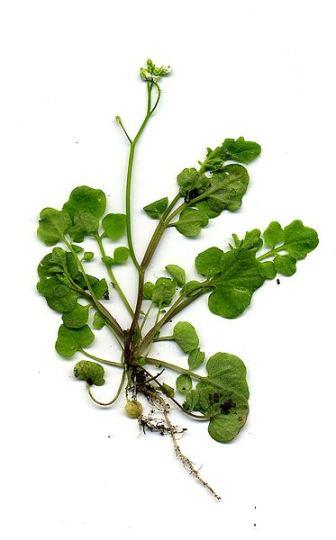Continuing in my quest to learn my weeds, today I am studying hairy bittercress, Cardamine hirsuta.
This is a photo of hairy bittercress in its less aggressive form (yes, dead; but I meant in flower, before the seed pods form).

Sometime in the course of the summer, hairy bittercress loses its innocence; its mate is obvious. Its seeds form in a silique (new Scrabble word!), which, of course, is Latin for “God-forsaken instrument of perpetual despair.” On an August afternoon, ambling through the garden on the way back from the mailbox, you may be tempted to do a light bit of weeding. You reach down for the spindly, twiggy wretch of a plant that you think, surely, must already have popped its clogs. You are just doing a bit of tidying. So at your gentle tug, you are shocked to hear a soft pop and witness a hailstorm of tiny seeds scattering in a circumference of astonishing size. You immediately enter the first of the five stages of grief: I didn’t just reseed this blasted waste of chlorophyll, did I?
Boy howdy, did you. Clearly, the way to deal with this plant is to search it out fearlessly and mercilessly in its youthful flower. Its fibrous root system makes it easy to extract, especially after a rain. But if, dear gardener, you go on vacation and allow circumstances to get to this burnt-twig phase, the plant is best extracted from the garden in the way good citizens dispatch dog poop:
- Ensleeve your arm with a plastic bag.
- Approach the target with the sensitivity of an explosive ordnance disposal tactician plying her craft.
- Pinch (or nearly pinch; now is not the time to detonate) the target (in this case, the stem) at its base.
- Invert the bag back over the target.
- Yank from the ground.
- Tie up tightly.
Whether further measures must be taken to ensure eradication (setting fire to the bag, collecting resulting ash and encasing it in a lead box, escorting lead box to Yucca Mountain, etc.) is a decision only the gardener can sort out by weighing his wallet and his conscience. The local fire brigade may have an opinion on the matter. Or, the gardener can wait until next spring (or winter, or maybe just late fall), when it will bloom again, providing another Sisyphean opportunity.

